How to Repurpose Your Old Blog Posts

Imagine you enter a grocery store to find wilted greens and gray beef on the shelves.
Yeesh.
You’d (almost) certainly leave before making a purchase, right? And probably never return.
The same goes for visitors to your website. While good content can stay relevant for some time, every blog post has a use-by date.
Once that time comes, you have two options: throw away your hard work or repurpose the old content.
In most cases, repurposing content is the better option.
If you want to restock your content store with fresh produce, we’re here to help. With this expert guide, you’ll learn why updating old content is important, and how you should go about it.
Ready to get started? Let’s roll!
Why You Should Update Old Blog Posts
Unlike groceries, your blog posts won’t rot away — not exactly. But there are some serious problems with outdated content. Repurposing or refreshing older content is a great way to turn these issues into opportunities.
Here are five key benefits of repurposing content, with input from some top marketing experts:
1. Outdated Content Damages Your Brand
“Your blog is a reflection of your company,” says Kathryn Marr, co-founder of digital marketing and web development company, Blue Ivory Creative. “It shows that you’re knowledgeable in your industry, provides valuable information that keeps potential clients interested, and is one of the keys to a successful search engine optimization (SEO) strategy.”
At least, that’s what should happen. The problem is, old content makes your blog seem abandoned and outdated. If statistics are out of date and source links are broken, visitors might assume you’re either poorly informed or careless. Either way, it’s not a good look.
Sometimes all it takes is updating older posts with newer statistics and sources to make your content seem brand new, helping you regain credibility.
2. Google Prefers Recent Content
Search engines like Google try to deliver the most relevant results for any given search term.
One key indicator of relevance is recency. If there are two very similar posts on the same topic, search engines tend to prefer the newer article.
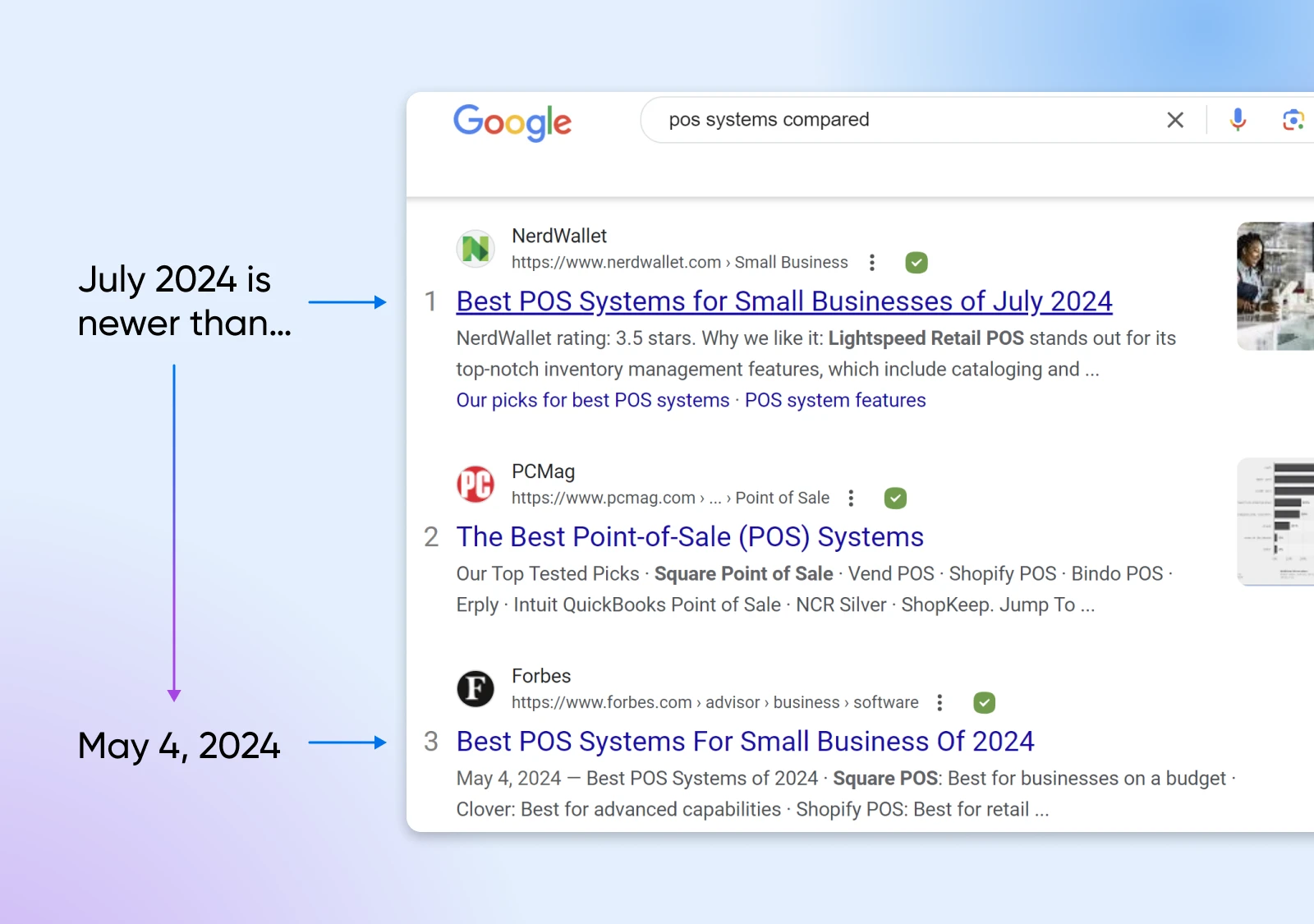
Repurposed content comes with a new publishing date and fresh ideas. It’s a good signal to search engines that your site is an up-to-date resource.
In the 2024 Google Algorithm leaks, we learn that the freshness factor is alive and well. Google is able to see when the last significant change was made to a page and can even ‘re-rank’ pages in real time based on freshness data.
And that’s not the only reason why you should update content for search.
Your older content might have been optimized for outdated SEO standards. One example is keyword stuffing — that’s adding as many keywords as possible into your content.
Before 2011, this was encouraged. Now, it’s bad practice and can lead to Google penalties under their updated spam policies.
Search Engine Optimization (SEO)
SEO enhances a site’s search rankings by focusing on factors like relevance and quality. Adjusting your site for these elements can significantly improve its visibility.
Read More
3. Quality Over Quantity
“There’s this content marketing myth that goes something like this: post as often as you can to get more traffic,” says Camilla Hallstrom, content marketing consultant at Influence With Content.
“Sure, blogging like that might have worked five years ago. But quality rules. People engage more with quality content, and it’s the best way to build a brand they love.”
Just as importantly, search engines now evaluate the overall quality of your website. If your site is packed with underwhelming content pieces, Google and Bing will assume you’re not a serious, credible source of information.
One way to fix this is by updating older posts so they are fully up to date, and more comprehensive.
4. Your Strategy (or Style) Might Have Changed
Content strategy tends to evolve over time. Look through your older posts, and you may discover that you were targeting different keywords back in the day.
Keyword
Keywords are words or phrases that describe the content of a website or web page. They help search engines match these elements to relevant searches.
Read More
Instead of contributing to the SEO impact of your website, these posts are actually telling search engines that your website is about something else. For example, your older posts might focus on services you no longer provide. You can solve this by reworking old posts to fit your current content strategy.
Similarly, the style of the content you produce might have changed. Blog posts that seemed cool at the time could appear cringeworthy to your audience today. It’s definitely better to update this type of content, rather than leaving it hanging around like an embarrassing photo from your high school years.
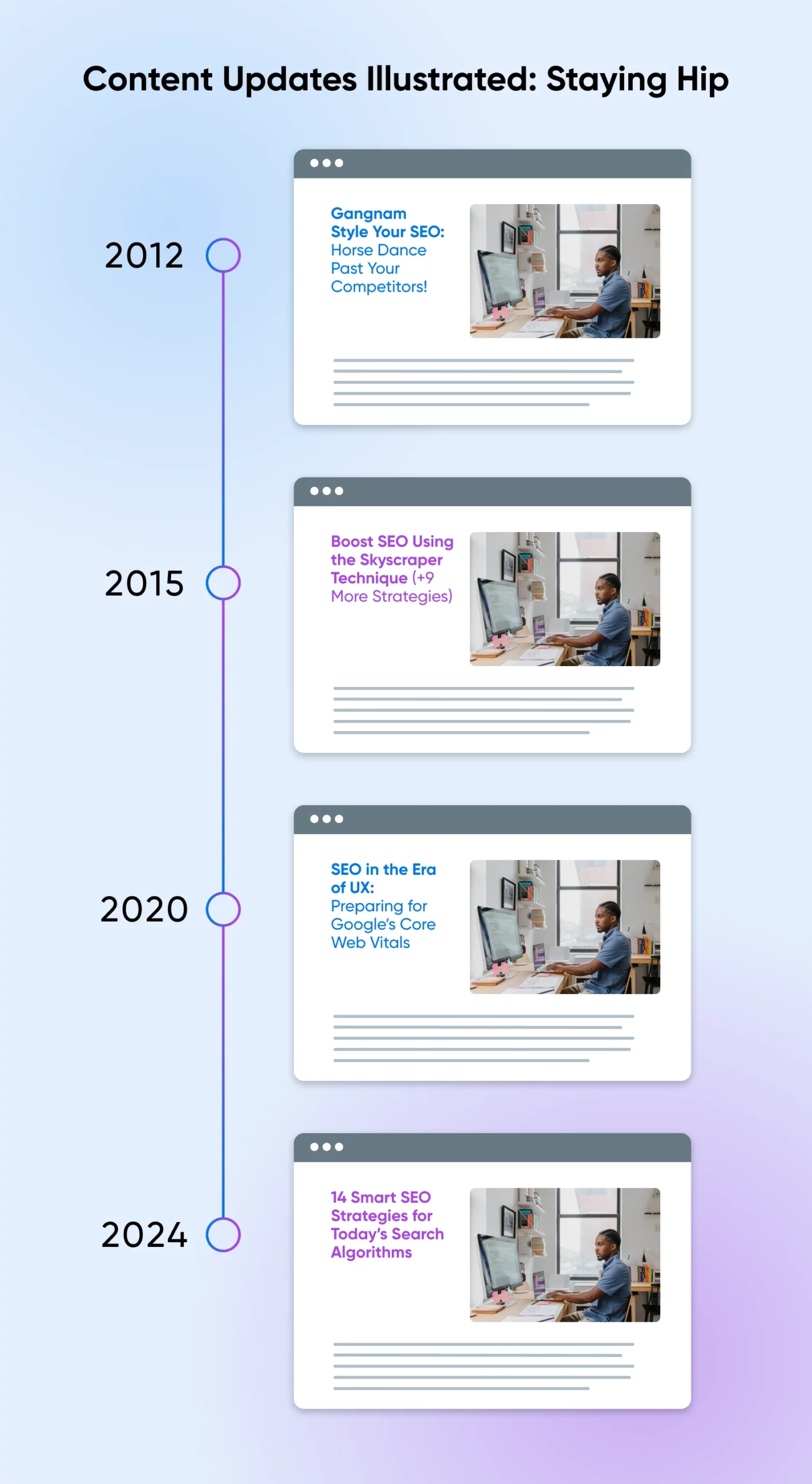
5. Creating New Content Is Hard Work
If old content is so bad, why not just hit delete? Because creating content from scratch is hard work.
When you delete old blog posts, you’re throwing away the effort you put in at the time. You might need to create new work — fast — to replace what you’ve tossed.
The case for refreshing or repurposing outdated content is summarized nicely by Phil Weaver, CMO of Learning Success:
“Content creation is a very resource-intensive process. Each old post should be considered a business asset. Just like any business asset, old posts should be maintained to get the maximum benefit from that asset.”
If you pay someone to create content for you, this message is even more important. Content repurposing is a much more cost-effective blogging strategy than creating new content.
How Often Do You Need To Update Your Content?
As a general rule, you should check any content that is three years old or more. Once a blog post reaches its fifth birthday, it’s time to blow out the candle and re-light it.
“I recommend content managers try to complete a full content audit once a year, provided your catalog isn’t thousands of articles deep,” says Sam Warren, marketing director at RankPay. “The larger your catalog, the more likely it is that you’ll want to develop a process for rolling updates in lieu of taking a project-based approach.”
If your industry is competitive, fast-moving, or is constantly innovating, then you’ll probably need to update your content more often to give yourself an edge — particularly in industries such as law, finance, and marketing.
How Do You Choose Which Posts To Update?
Updating a post might sound like a lot of work. Keep in mind, however, that repurposing old content means reclaiming time and effort from the past.
What’s more, renewing or repurposing your content doesn’t have to be a huge project. Sometimes, it only takes a few tweaks to freshen up an old post.
Here’s how to decide which content is worth revamping:
1. Measure Analytics:
“You might have more than a few blog posts on your site, and in that case, it doesn’t make sense to update all your content on a regular basis,” says Hallstrom from Influence With Content. “Instead, check your analytics once in a while (at least every 12 months) to identify your top content.” That means content that gets traffic, content that could get traffic in the future, and content that converts.
You can check this with tools like Google Analytics, Google Search Console, and Ahrefs. Be sure to add conversions to the analytics you’re tracking.
Update posts that:
- Are already ranking high on Google, to ensure you maintain your spot.
- Are close to ranking high (since just a few updated tweaks can increase their standing).
- Previously got a lot of attention on social media — updating these posts may unlock similar attention again.
2. Research Your Industry:
Take the time to see what’s new in your field. “Then, research your competition,” says Hallstrom.
“Has new content been published that outranks you on Google?”
It might be worth updating your content in line with the latest developments in your industry.
3. Check Your User Metrics
See how people interact with your content, including how much time is spent on pages, bounce rate, click-through rate, and conversion rate. This information can be found via Google Analytics.
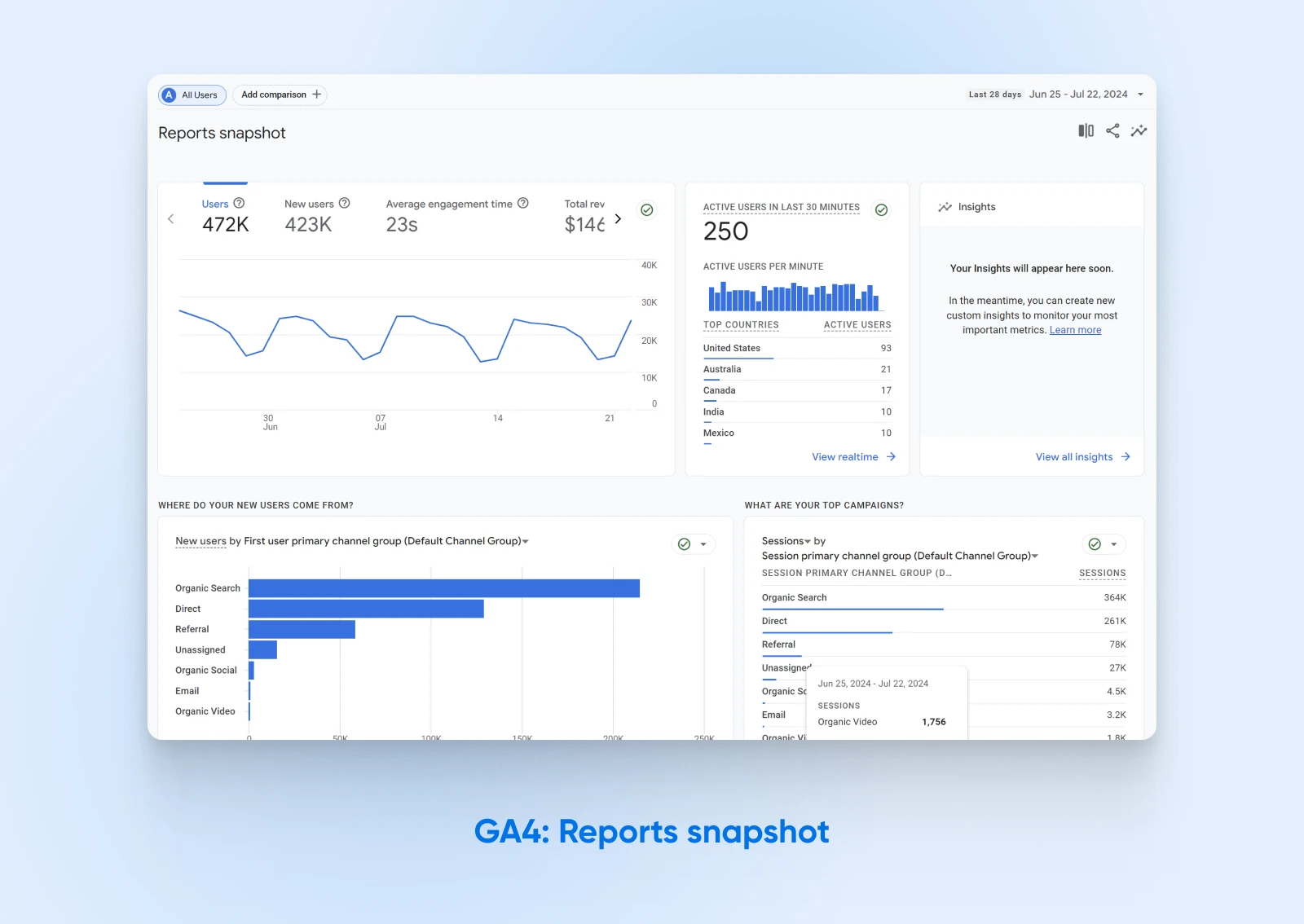
If your engagement is low, there are updates you can make to improve it. Also, check user comments to see if people have questions about your content — you’ll want to add answers to your refresh.
“You can also use user metrics to improve your conversions,” says Hallstrom. “If your content isn’t converting as it should, these metrics will help you understand why.”
4. Conduct an SEO Analysis
Search habits change, so it’s worth checking that your SEO strategy is up to date. You can use keyword analytics to ensure you’re targeting the right keywords.
“The insights you get from your user metrics will help you decide if your content needs to be optimized for engagement,” says Hallstrom.
“Use Google Search Console to see which keywords people are using to find your content, and to check your click-through rates. These metrics can pinpoint if your SEO titles need updates.”
How To Refresh Your Blog: 12 Ways To Repurpose Content
There are many different ways to repurpose your content, from minor updates to complete overhauls. You can even convert an old blog post into different content formats, or split it into multiple pieces of content.
To give you some idea of the possibilities, here’s a rundown of our favorite content repurposing strategies:
1. Update Your Stats and Sources
Good content recycling starts with fact-checking. Check that the information in your original post is still accurate. This is particularly important in tech and other fast-moving industries, where walkthroughs can quickly become out of date.
You should also make sure that any included statistics are still relevant, with source links that still work. Consider adding newer information and links to resources that weren’t available at the time your post was originally created.
This form of content refresh is great for fairly recent articles that are still holding up well!
2. Add New Visual Content
Words are great, but they’re not always as entertaining as visual content. One way to upgrade existing written content is by adding newer, better visuals.
Images can break up long sections of text, and help readers understand complex ideas. What’s more? Research shows that information delivered through visual content is significantly easier to remember than text alone.

At the very least, you can jazz up old blog posts with new stock photos. Custom graphics are even better. If you can design a simple diagram or bullet point list that summarizes the written content, you’ll make your post far more engaging.
Just as importantly, images of this type are much more likely to be shared on social media, therefore, driving traffic to your post.
3. Shoot a Companion Video
Images aren’t the only type of visual content you can include. For important blog posts, such as pillar content, it might be worth shooting a short video to summarize or expand on the written content. Even if you don’t want to appear on camera, you can use slides, screen recordings, and voiceovers to add something new. Try Loom for walkthroughs, for example.
“This works really well for tutorials, recipes, and similar types of posts,” says Kathryn Marr of Blue Ivory Creative. “Film a video walking your readers through something you described in a blog post. Then, share it on your social media accounts and add it to the old post for more engagement.”
4. Re-optimize for SEO
In terms of improving your search rankings, a refreshed older post can be just as valuable as a brand-new piece of content.
“Consistent, high-quality posts are critical for a good SEO strategy,” says Marr. “Optimizing them for specific, strategic keywords, adding alt tags to images, and increasing the length and quality of content can go a long way to making that content rank.”
Using a keyword tool, such as Ahrefs or Buzzsumo. Sam Warren of Rankpay recommends taking a look at how the keyword landscape has shifted for each piece of content.
“Maybe your original keyword has lost significant volume, or maybe a competitor came in and created something even better than your original piece,” he says. “Whatever the cause, it’s often going to be worth the effort to identify the most promising keywords that the old content can rank for and then go after them.”
This principle applies even when the original post wasn’t a hit with readers. “If it is good information, but it did not do exceptionally well, then we closely look at the title and featured image,” notes Phil Weaver, CMO of Learning Success. “We will likely rewrite the title and replace the image.”
While you’re at it, enable rich snippets on your blog. “These provide additional information that will show up on search engines like reviews, author information, and so on.” says Marr.

5. Edit for Readability
Of course, while SEO is essential for driving blog traffic, you also want to focus on content engagement.
“Your content needs to be easy to read and skim through,” says Camilla Hallstrom from Influence With Content. “Simple words, short sentences, and short paragraphs.” If you find older posts that are a little verbose, try cutting them down to size and improving the formatting.
This kind of refresh is good for engagement and positive for SEO. “Make sure you offer an amazing user experience,” says Hallstrom. “That’s what makes Google happy no matter how many times it changes algorithms.”
6. Curate Your Greatest Hits
Articles that were published in the past couple of years might not need much of an update.
Nonetheless, you can squeeze more juice out of these posts by curating them into new collections or round-up posts.
Here are some examples:
- “Our Top 20 Marketing Tips”
- “The Best Flower Arranging Tutorials of 2024”
- “Our Favorite Posts From This Year”
7. Add New, Original Research
Content marketing is massively competitive. If you want your article to shine, you really need to offer a new take or more unique insights.
For example, the self storage brand, Neighbor, analyzes data every year to update their rankings of the Top 25 Cities in America.
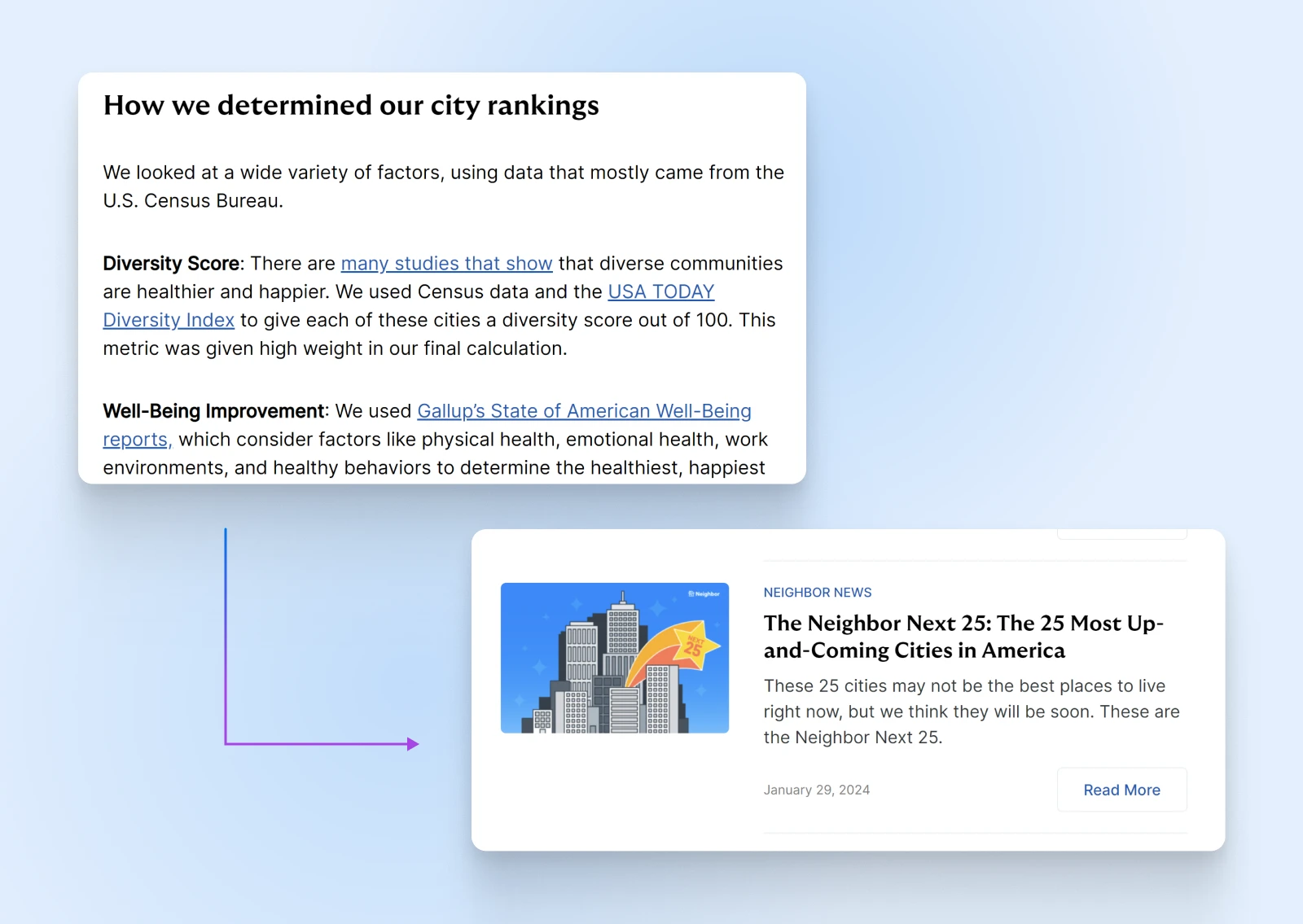
One way of achieving this is by adding original research to a successful post. Even a small industry survey can reveal interesting trends that will elevate a tired post and put you one step ahead of the competition.
8. Convert Your Post Into Social Content
Just like a scrapyard salvages parts from crashed cars, you can use the best parts of your older content to make something new.
One option is to pull out ideas and convert them into snappy social media posts. You can even create shareable graphics that highlight key quotes from your original post.
This content repurposing strategy works best when you refresh the article at the same time. This means you can engage people on social platforms and then link directly to the rejuvenated article.
9. Create New Infographics
If you have long-form content that’s chock full of statistics, you could try making an easy-to-read infographic. “These are great for generating organic traffic via social shares,” says Kathryn Marr. “Especially on platforms like Pinterest.”
Adding this element to your content will boost its value to your readers.
10. Record Your Blog Post as a Podcast
The popularity of podcasts has exploded in the past decade. And yet, many niches are still relatively open. There’s certainly much less competition in podcasting than there is in SEO.
If you’re struggling to make a mark on Google, you might want to consider repurposing your blog content in audio format. You could literally just read out the content of existing posts, or update the content a little to make it better for listening.
And as with infographics, your podcasts can serve as promotion for your blog.
11. Reuse Text-Based Content in Video Form
Remember when we talked about adding a video to your blog posts? Well, you can also use written content from your articles to create more video content.
A single, well-researched blog post can hold enough insights for two or three short-form videos that you can post on Instagram, YouTube, or LinkedIn.
Some creators even share videos where they talk through their latest blog post, almost like a preview.
For example, the pet brand Ruffwear often posts an Instagram reel to promote recently published blog posts.
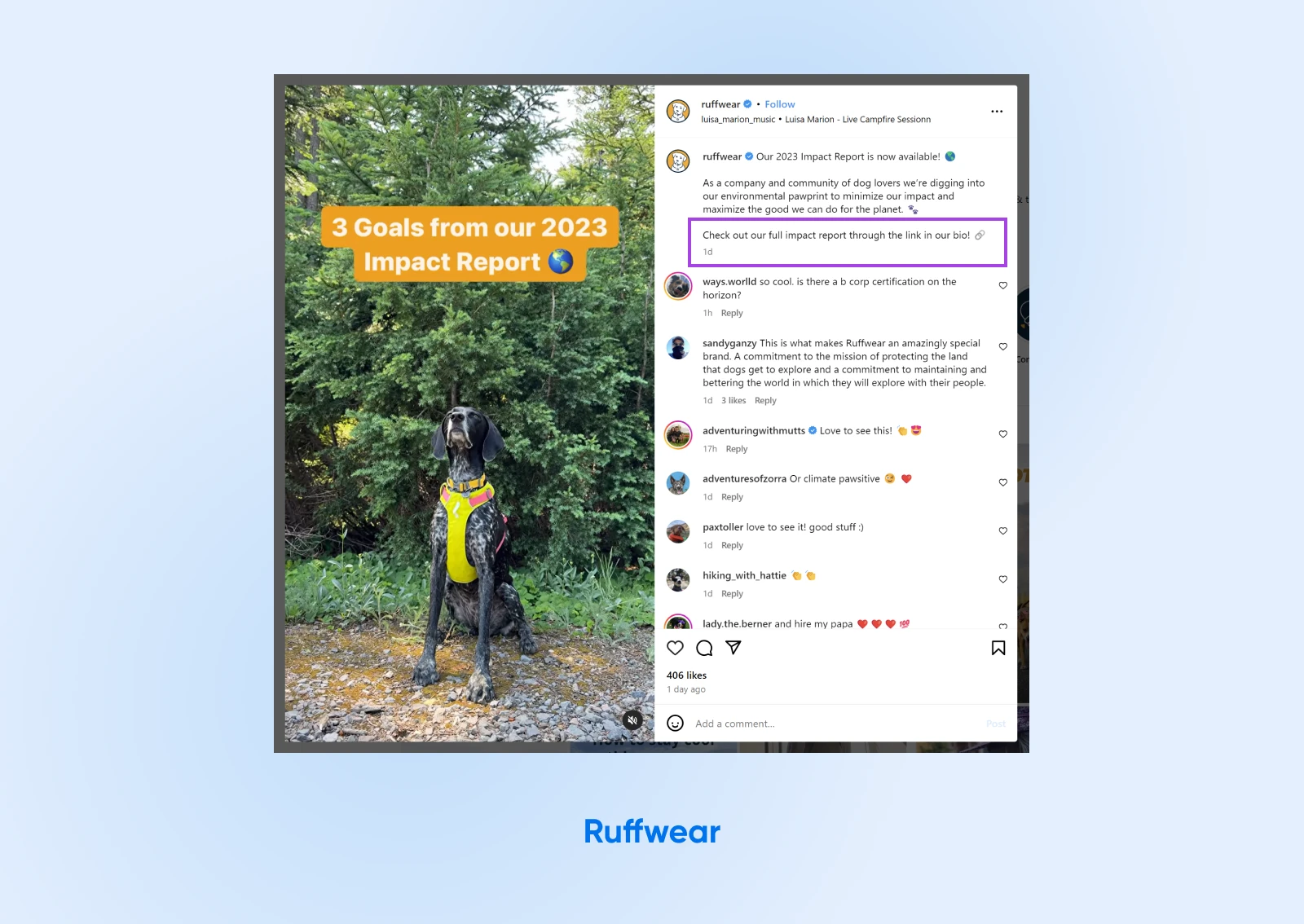
12. Use Your Blog Content in an E-book
Publishing a digital book is a great way to prove your expertise in your field. The only downside is that writing an entire book from scratch takes time.
Luckily, there’s a (relatively) simple solution: use your existing content!
Some long-form posts can be copied and pasted wholesale as new chapters. In other cases, you might want to expand further on what you have, or adapt the tone to match the rest of your e-book.
How To Maximize the Impact of Repurposed Content
While refreshing and repurposing content is way easier than starting from scratch, there’s still some effort involved.
Here are some quick tips on maximizing the impact of your hard work:
1. Make the Refresh Last Longer
To help content last longer, try to avoid seasonal posts or content with a short time frame of relevance. “Think about what people will want to read in five years,” says Marr. “Put the time into creating high-quality content that you’re going to be proud of years from now.”
Hallstrom offers similar advice. “If you create evergreen content from the get-go, you don’t have to worry as much about updating it. Take a look at the content that’s already out there. How can you make something that’s even better?”
2. Promote, Promote, Promote
If you’re going to make the effort to repurpose content, save some energy for promotion. “Old posts can drive new traffic by putting them on a similar promotion schedule as new posts,” says Weaver.
Here are Marr’s suggestions:
- Link to your old blog posts in new blog posts.
- Reach out to bloggers and influencers who might be willing to share your posts with their audience.
- Link to the posts in guest posts that you write for other sites.
- Promote the stories as “With new content!” or “Now updated!” on social platforms, for example.
- Create “Best of” posts that highlight categorized old posts.
Good content distribution can make a huge difference to the performance of your repurposed articles.
3. Chase Backlinks
Backlinks are a key ingredient for success in SEO, and your newly updated posts can help you secure those valuable connections.
Here are some tactics to try:
- Write a guest post for a popular site in your niche, and ask for a backlink to your refreshed content in return.
- Reach out to websites that link to outdated statistics and resources, and ask if they would consider linking to your content instead.
Offer your content as a resource for journalists to write about, using a platform like Help a Reporter Out (HARO).

Turning Old Into Gold
Repurposing can be a really powerful strategy for content marketing. The key is to be laser-focused on what you want to achieve. “When you repurpose a post, do it in a way that really fits your business plan,” says Kathryn Marr.
Here’s a quick recap of the key points to guide you through the process:
While you’re thinking about your content, it might be worth checking the performance of your site. If posts take ages to load, you won’t feel the full benefits of repurposing.
For an instant upgrade, try switching your hosting to DreamHost. With automatic updates and strong security, our managed WordPress hosting solution takes care of the boring stuff so you can focus on what really matters: creating great content that drives traffic.
Sign up today to try it for yourself!

Pro Services – Marketing
Get More Visitors, Grow Your Business
The best-designed site is worthless if no one can find it. Leverage proven online marketing strategies and techniques to help more of your target audience find you.
See More



